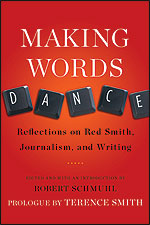Of the many memorable phrases sportswriter Red Smith bestowed on the English language, the most enduring may be his description to a group of New York Herald Tribune advertising salesmen of the pleasure he found in writing a column: “All you do is sit down and open a vein and bleed it out drop by drop.”
His devotion to finding the precise word is matched only by his tenacity at producing so many of them; he spent much of his 55-year career writing six or seven columns a week, plus a few articles along the way. His output only stopped with his death in 1982, but the spirit of Smith’s prose lives on in the Red Smith Lecture that the University of Notre Dame, Smith’s alma mater, inaugurated 27 years ago in which journalists and authors discuss the craft of writing.
In “Making Words Dance: Reflections on Red Smith, Journalism, and Writing,” Robert Schmuhl, the Walter H. Annenberg-Edmund P. Joyce Chair in American Studies and Journalism at Notre Dame and the book’s editor, has collected 14 of these lectures. The inaugural speaker, Smith’s New York Times colleague James “Scotty” Reston addressed the impact of sports on politics; in 2008, political journalist Tim Russert delivered the lecture just months before his death. RELATED ARTICLES
“Frank Deford: Sports Writing in the Internet Age”
- Frank Deford
“The Sports Beat: A Digital Reporting Mix—With Exhaustion Built In”
- Dave Kindred Schmuhl weaves into these lectures discussion and comment; there is a roundtable of sorts, for example, among Dave Kindred, who spoke in 1991, Bob Hammel, who delivered a response, and Jane Leavy, who spoke about women sportswriters within days of that lecture.
Sports serve as a unifying thread and jumping-off point for reflection. Yet at the core of these lectures and discussions resides the craft of journalism and the lessons learned by these veteran “typewriter jockeys,” to use Smith’s embracing euphemism.
For those uninitiated in Smith’s writing, Schmuhl scatters 15 of his columns and articles throughout the book including “Miracle of Coogan’s Bluff,” a game story he wrote after Bobby Thomson’s “shot heard ’round the world” sent the New York Giants to the 1951 World Series. It opens with Smith’s only somewhat hyperbolic declaration:
His devotion to finding the precise word is matched only by his tenacity at producing so many of them; he spent much of his 55-year career writing six or seven columns a week, plus a few articles along the way. His output only stopped with his death in 1982, but the spirit of Smith’s prose lives on in the Red Smith Lecture that the University of Notre Dame, Smith’s alma mater, inaugurated 27 years ago in which journalists and authors discuss the craft of writing.
In “Making Words Dance: Reflections on Red Smith, Journalism, and Writing,” Robert Schmuhl, the Walter H. Annenberg-Edmund P. Joyce Chair in American Studies and Journalism at Notre Dame and the book’s editor, has collected 14 of these lectures. The inaugural speaker, Smith’s New York Times colleague James “Scotty” Reston addressed the impact of sports on politics; in 2008, political journalist Tim Russert delivered the lecture just months before his death. RELATED ARTICLES
“Frank Deford: Sports Writing in the Internet Age”
- Frank Deford
“The Sports Beat: A Digital Reporting Mix—With Exhaustion Built In”
- Dave Kindred Schmuhl weaves into these lectures discussion and comment; there is a roundtable of sorts, for example, among Dave Kindred, who spoke in 1991, Bob Hammel, who delivered a response, and Jane Leavy, who spoke about women sportswriters within days of that lecture.
Sports serve as a unifying thread and jumping-off point for reflection. Yet at the core of these lectures and discussions resides the craft of journalism and the lessons learned by these veteran “typewriter jockeys,” to use Smith’s embracing euphemism.
For those uninitiated in Smith’s writing, Schmuhl scatters 15 of his columns and articles throughout the book including “Miracle of Coogan’s Bluff,” a game story he wrote after Bobby Thomson’s “shot heard ’round the world” sent the New York Giants to the 1951 World Series. It opens with Smith’s only somewhat hyperbolic declaration:
Now it is done. Now the story ends. And there is no way to tell it. The art of fiction is dead. Reality has strangled invention. Only the utterly impossible, the inexpressibly fantastic, can ever be plausible again.




